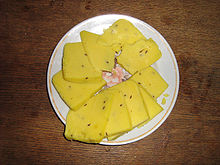Jāņi cheese
| Jāņi cheese | |
|---|---|
 Slices of Jāņi cheese | |
| Other names | Caraway cheese (ķimeņu siers) |
| Country of origin | Latvia |
| Source of milk | cows |
| Texture | soft, compact, slightly grainy and homogeneous throughout |
| Fat content | <30% |
| Dimensions | cylinder 4–6 cm in height and 8–30 cm in diameter |
| Aging time | at least 1–2 hours |
| Certification | TSG 2015 |
| Named after | Jāņi |
Jāņi cheese (Latvian: Jāņu siers) is a Latvian sour milk cheese, traditionally eaten on Jāņi, the Latvian celebration of the summer solstice. Nowadays the cheese has become one of the symbols of Latvian culture.[1]
In 2021, it was reported that Jāņi cheese was losing its popularity due to the COVID-19 pandemic and consumers opting out for other types of cheeses, such as mozzarella, feta, as well as hard cheese, and aged cheeses.[2]
Production
[edit]
The basic ingredients of the dish are curd produced from both soured milk and fresh milk. Traditionally, caraway seeds, salt and eggs are added during cooking, as well as butter or cream if wishing to increase fat content. The cheese is made by heating whole milk, adding curd, and then cooking the mixture until fluffy curds separate from a clear whey. The whey is discarded when the cheese mass reaches a temperature of 72–77 °C (162–171 °F). At this point, the curds are placed into a skillet or cooking pan, and a mixture of egg, butter, salt, and caraway seeds is stirred into it. Once a solid and firm ball is formed, the cheese is placed in a cheesecloth to drain and often pressed by placing weight on it. Generally, the cheese is prepared a few days before eating and is allowed to ripen in a cool place before consumption.[3]
Certification
[edit]
On November 16, 2015, Jāņi cheese was included in the EU Traditional Speciality Guaranteed (TSG) register under the name Jāņu siers.[4] Currently 5 manufacturers ("Valmieras piens", "Rankas piens", "Lazdonas piensaimnieks", "Straupe", and "Dundaga") fulfil the TSG criteria and can label their product as Jāņu siers.[5]
References
[edit]- ^ "Jāņi cheese – a symbol of Latvian identity". Public Broadcasting of Latvia. June 21, 2019. Retrieved June 22, 2019.
- ^ "Traditional Latvian Jāņu cheese loses popularity, stores observe". Public Broadcasting of Latvia. May 10, 2021. Retrieved May 10, 2021.
- ^ Linda Dumpe; Anna Šmite; Aija Golde (2004). Jāņi cheese. Riga: SO "Cheese Club". p. 204. ISBN 9984-976-20-3.
- ^ "Traditional Midsummer cheese wins EU protection". Public Broadcasting of Latvia. November 17, 2015. Retrieved June 23, 2017.
- ^ Matisone, Gunta (May 13, 2016). "How to spot authentic Midsummer cheese". Public Broadcasting of Latvia. Retrieved June 23, 2017.
External links
[edit]- Jāņi cheese Traditional Speciality Guaranteed specification (in English). Official Journal of the European Union
